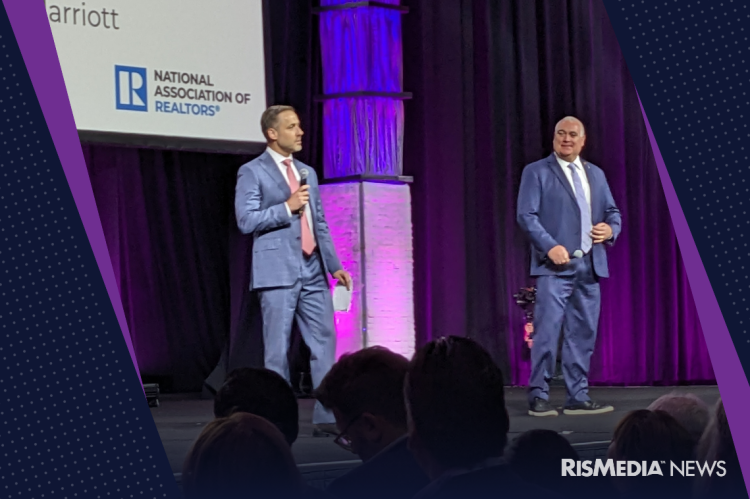Above: NAR General Counsel Jon Waclawski (left) and NAR President Kevin Sears (right) take the stage at the midyear Legislative Meetings in June.
What is in a name?
For the National Association of Realtors® (NAR), the ubiquitous term for members—coined almost 110 years ago—means a lot. And it should mean a lot for Realtors® themselves, too, who have been paying the association since 1998 to promote the brand to consumers, and whose businesses rely tremendously on the trust and professionalism that the word is intended to represent.
But over the past couple of years, the Realtor® name has taken a hit. In the media and in the courtroom, the word “Realtor®” popped up alongside terms like “price-fixing,” “lawsuit” and “sexual harassment,” to the chagrin of members. NAR confronted backlash from both inside and outside the organization, fighting an uphill battle to defend its name to consumers, as well as to the real estate professionals it serves.
“We’ve had a denigration of our brand based on bad media, poor media,” NAR President Kevin Sears tells RISMedia.
With a new leadership team at NAR, the “Realtor®” brand appears to be taking on new priority amid larger efforts to raise the value proposition of the organization, with a new focus on services and a reinvigorated push for trademark protection, as a revamped NAR hones in on its core mission.
“We’d like to think that the majority of (the negativity) is in our rearview mirror, right? It’s behind us. And so we need to be looking forward,” Sears adds.
Back in June, RISMedia received documents detailing new guidance NAR was pushing out to the media and its own internal stakeholders focused on how to use—and not use—the word “Realtor®.” Shortly after, the organization announced a brand new legal role, with experienced intellectual property attorney Leslie Nettleford-Freeman joining NAR as vice president of legal affairs and brand protection.
But defending the Realtor® trademark is only part of a larger effort to elevate what it means to be a Realtor®, according to Sears. As real estate professionals get back to doing business (in what is still a difficult market), do members want their hard-earned dollars dedicated to these issues? What is NAR specifically doing to turn the Realtor® brand into something that adds value to members?
“For me, what it boils down to is—how do we protect the consumer in the transaction?” says Sears. “We get to promote the Code of Ethics and our protection of the consumer differently than a real estate licensee does.”
The big ‘R’
According to NAR, the term Realtor® was first coined during the days of “curbstoning” in the early 20th century, explicitly to differentiate members (of what was then known as the National Association of Real Estate Boards, or NAREB) from shady or incompetent amateurs. It was officially adopted by NAREB in 1916, but not trademarked until the 1940s.
How does the Realtor® brand fit into this new world?
Nate Johnson, a broker in St. Louis who previously served as VP of advocacy at NAR, says that he speaks to clients about the difference between Realtors® and real estate licensees who aren’t members, often referring to education and the Code of Ethics.
But he also says he takes time to talk about how NAR advocates for homeowners and property rights, pointing to state-level legislative wins (specifically, a constitutional amendment in Missouri that banned real estate transfer taxes, championed by NAR and the Missouri Association of Realtors®).
“I like to help them understand (when they ask), ‘Why is Nate in Washington, D.C.? Doesn’t he sell real estate in St. Louis?’ I want to help them understand what I’m doing when I’m working at the national level and how it comes back home to protect them and their interests.”
Sears and new leadership at NAR have also touted what they refer to as a “basecamp” role for the organization, refocusing on ways to support the everyday business priorities of members—namely, getting clients and getting to the closing table. Sears affirms that again, and connects that goal to the Realtor® brand.
“Let’s help them get to their next deal. As we are helping them to be successful and get to their next deal, their next transaction to help the consumer—there is a differentiation. And it’s the professionalism that Realtors® can bring to the table, the expertise that we have,” he says.
But with $39 million spent on advertising and promotion (in 2023, the most recent year NAR’s tax filings are available), does the Realtor® name resonate with consumers today?
Asked directly if the long-term goal is to make sure that consumers immediately understand the difference in value between an agent who is also a Realtor® and an agent who isn’t, Sears defers, but adds that what will resonate most with consumers is trust.
“The fact that we subscribe to the Code of Ethics, which is pro-consumer, and we put the consumer’s interest before our own,” he says. “And that’s what we need to clearly articulate as we’re having the conversations.”
Sears also admits that it’s not always the case that consumers see that commitment to client’s interests. Johnson adds that he doesn’t believe buyers and sellers hold a permanent or long-term bias against the brand based on the lawsuits or recent media coverage, meaning that both NAR and Realtors® individually have an opportunity to elevate the whole industry in the eyes of consumers.
“Unfortunately, our industry may not have the best reputation among consumers, but most people feel that the Realtor® that they’ve worked with is someone that they would tell their friends and family about and work with again.”
Sears claims that conversations about advocacy are also part of elevating the brand, noting like Johnson that Realtor® members can position themselves as representing a preeminent force in politics, both at the federal and more local levels.
“There is no National Association of Home Buyers. There’s no National Association of Home Sellers. There’s no National Association of Real Estate Agents,” he says. “It’s the National Association of Realtors®, and we’re the ones who on a daily basis, fight for people’s ability to freely buy, sell, lease and transfer real property.”
Sears also deferred on specifics regarding the consumer ad campaign, which Realtors® have the option to pay into along with their dues every year. At its midyear meetings, NAR decided it would be dipping into those monies to pay off some of the $418 million agreed to in the settlement.
But he also promises there is a “next iteration” of consumer outreach and communication and that this also remains “a priority” as NAR onboards new staff.
“We need to look at our entire comms plan and figure out how we are going to do this,” he says.
Laws and locals
A source within NAR emphasized that part of the push to revamp the brand is an emphasis on enforcing the trademarks and copyright related to the actual usage of the word “Realtor®.” One broad complaint from members during the saga of the commission lawsuits is that NAR was not effectively navigating a hostile media landscape.
NAR legal counsel are more aggressively reaching out to media outlets to ensure proper usage of the term Realtor®, according to the source—primarily due to regular efforts to protect the trademark, as required by law, but also as a way to protect the brand. So far, the source said, there hasn’t been any significant issues and media outlets are willing to make corrections.
Member usage is also important. Johnson admits that there are “different levels of understanding” among Realtors® regarding how to use the term, and the goal is to not use the term synonymously with real estate agents.
The source within NAR said the organization also corrects members on usage, but rarely runs into major issues there, either.
In the end, though, Realtors® are unlikely to put significant effort into elevating or promoting the brand if it isn’t offering them value. Sears notes that NAR’s conversations with big brokerages—many of whom remain disgruntled after being excluded from the settlement agreement—have often focused on adding value for agents.
“They’re not easy conversations, but when it comes back down to it, they want to be successful in their business, and they realize that having the National Association of Realtors® strong, viable and successful ultimately will benefit them,” Sears says.
How does that filter down to the individual agents, who are the ones speaking directly to consumers about what NAR is and what being a Realtor® means?
That comes back to another priority espoused by the new NAR leadership—better communication and relationships with local associations. At a panel for small brokers at NAR’s midyear legislative meetings in June, NAR presented data showing how much more engaged many brokers are with their local associations compared to NAR.
Sears says that while NAR hopes to build trust on its own with brokers, it’s not a bad thing that local associations are the primary contacts in the community. It also helps more closely connect the brand to the people who are living, working and transacting in a given area.
He describes his own experience of getting licensed in 1994, joining the different levels of Realtor® associations.
“I saw in real time what exactly it meant to be part of the Realtor® association,” he says. “It was in my hometown. We were involved; we are a vital part of the community.”












